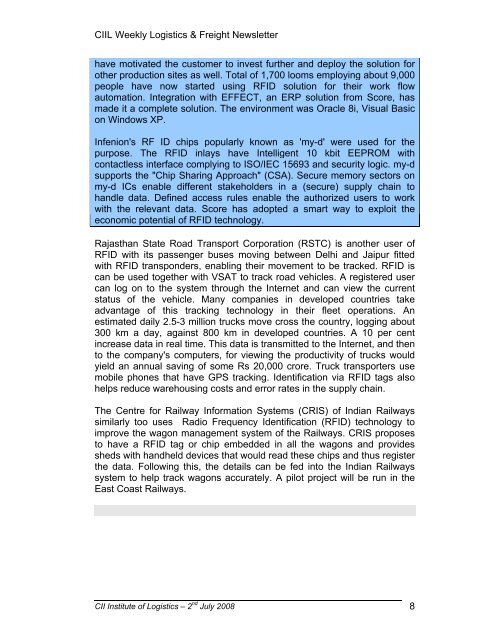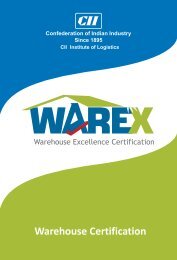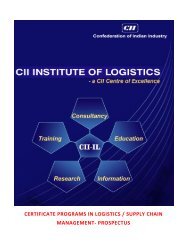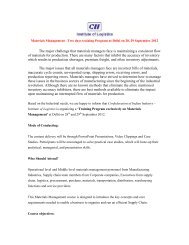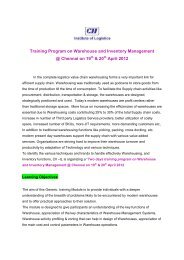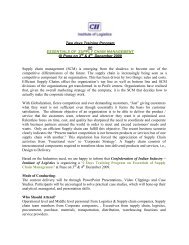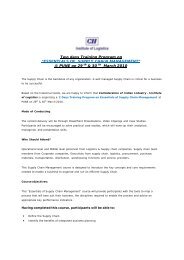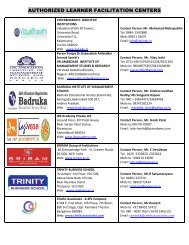CIIL Weekly Logistics Newsletter CII Institute of Logistics â 2nd July ...
CIIL Weekly Logistics Newsletter CII Institute of Logistics â 2nd July ...
CIIL Weekly Logistics Newsletter CII Institute of Logistics â 2nd July ...
Create successful ePaper yourself
Turn your PDF publications into a flip-book with our unique Google optimized e-Paper software.
<strong><strong>CII</strong>L</strong> <strong>Weekly</strong> <strong>Logistics</strong> & Freight <strong>Newsletter</strong><br />
have motivated the customer to invest further and deploy the solution for<br />
other production sites as well. Total <strong>of</strong> 1,700 looms employing about 9,000<br />
people have now started using RFID solution for their work flow<br />
automation. Integration with EFFECT, an ERP solution from Score, has<br />
made it a complete solution. The environment was Oracle 8i, Visual Basic<br />
on Windows XP.<br />
Infenion's RF ID chips popularly known as 'my-d' were used for the<br />
purpose. The RFID inlays have Intelligent 10 kbit EEPROM with<br />
contactless interface complying to ISO/IEC 15693 and security logic. my-d<br />
supports the "Chip Sharing Approach" (CSA). Secure memory sectors on<br />
my-d ICs enable different stakeholders in a (secure) supply chain to<br />
handle data. Defined access rules enable the authorized users to work<br />
with the relevant data. Score has adopted a smart way to exploit the<br />
economic potential <strong>of</strong> RFID technology.<br />
Rajasthan State Road Transport Corporation (RSTC) is another user <strong>of</strong><br />
RFID with its passenger buses moving between Delhi and Jaipur fitted<br />
with RFID transponders, enabling their movement to be tracked. RFID is<br />
can be used together with VSAT to track road vehicles. A registered user<br />
can log on to the system through the Internet and can view the current<br />
status <strong>of</strong> the vehicle. Many companies in developed countries take<br />
advantage <strong>of</strong> this tracking technology in their fleet operations. An<br />
estimated daily 2.5-3 million trucks move cross the country, logging about<br />
300 km a day, against 800 km in developed countries. A 10 per cent<br />
increase data in real time. This data is transmitted to the Internet, and then<br />
to the company's computers, for viewing the productivity <strong>of</strong> trucks would<br />
yield an annual saving <strong>of</strong> some Rs 20,000 crore. Truck transporters use<br />
mobile phones that have GPS tracking. Identification via RFID tags also<br />
helps reduce warehousing costs and error rates in the supply chain.<br />
The Centre for Railway Information Systems (CRIS) <strong>of</strong> Indian Railways<br />
similarly too uses Radio Frequency Identification (RFID) technology to<br />
improve the wagon management system <strong>of</strong> the Railways. CRIS proposes<br />
to have a RFID tag or chip embedded in all the wagons and provides<br />
sheds with handheld devices that would read these chips and thus register<br />
the data. Following this, the details can be fed into the Indian Railways<br />
system to help track wagons accurately. A pilot project will be run in the<br />
East Coast Railways.<br />
<strong>CII</strong> <strong>Institute</strong> <strong>of</strong> <strong>Logistics</strong> – 2 nd <strong>July</strong> 2008 8


